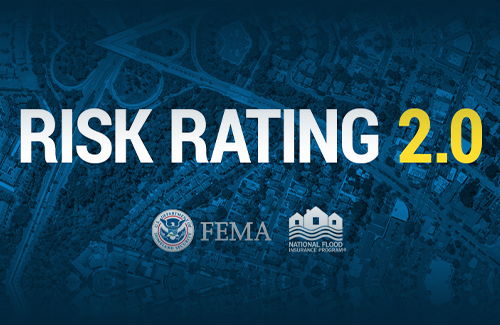As you have probably heard, FEMA has updated the NFIP’s rating methodology by implementing Risk Rating 2.0. This new rating methodology leverages industry best practices and cutting-edge technology to deliver rates that are actuarially sound, easier to understand, and better reflect a property’s individual flood risk.
Your clients will turn to you as their trusted insurance advisor with questions on how Risk Rating 2.0 will affect them. Use the frequently asked questions listed below to help them understand the impact of these changes:
Why is the National Flood Insurance Program (NFIP) doing this now?
While NFIP’s previous rating methodology was developed using actuarially sound principles, it has not changed since the 1970s. Over time, this has inadvertently caused a disparity and policyholders with lower-valued homes are paying more for their insurance coverage than they should, while policyholders with higher-valued homes are paying less.
Without action, the gap between rate payments and claims payouts will continue to widen—making it harder to meet the needs of our customers. As flooding events become more frequent and severe, Risk Rating 2.0 will allow us to more accurately reflect flood risk, as well as help disaster survivors recover faster after floods. With access to the latest technology and flood mapping data, NFIP can provide policyholders a better understanding of how their individual flood risk is reflected in the cost of their insurance.
When did Risk Rating 2.0 go into effect?
New rates will be implemented through a phased approach:
- Phase I: New policies beginning Oct. 1, 2021, are subject to the Risk Rating 2.0 rating methodology. As of Oct. 1, existing policyholders eligible for renewal are given the option to take advantage of immediate decreases in their premiums.
- Phase II: All policies renewing on or after April 1, 2022, will be subject to the Risk Rating 2.0 rating methodology.
How will the new rating methodology impact the affordability of a policy?
FEMA recognizes and shares the concern about flood insurance affordability. Currently, FEMA does not have the statutory authority to consider affordability in setting rates. We are ensuring the transition to new rates under Risk Rating 2.0 complies with all statutory rate increases in place by Congress and continue to examine flood insurance affordability options.
How will premium increases or decreases impact policyholders?
Current policyholders whose premiums will decrease under Risk Rating 2.0 will transition to the lower rate at the first renewal of their policy. Any premium increases will transition gradually within the existing statutory limits until the full-risk rate for the property is reached.
Do changes from this initiative require legislative action or approval of Congress?
The National Flood Insurance Act requires FEMA to periodically review, and if necessary, revise the way we set non-discounted premium rates based on accepted actuarial principles. By leveraging modern technology and advanced actuarial practices, Risk Rating 2.0 is helping FEMA better meet the objectives already laid out by Congress.
Will Risk Rating 2.0 change mandatory purchasing requirements?
No, lenders will continue to use the current effective Flood Insurance Rate Maps (FIRMs) to determine if a building is located within a high-risk flood area (Special Flood Hazard Area) and if the purchase of flood insurance is mandatory under federal law. In addition, lenders still have the prerogative to require flood insurance even in the absence of a federal mandate.
How does Risk Rating 2.0 affect the grandfathered rating discount?
Grandfathering was available to policyholders when map changes resulted in a rating zone or base flood elevation change. Because Risk Rating 2.0 provides each building’s individual flood risk, all policies formerly eligible for grandfathering will transition to their new full-risk premium. Increases will be gradual within the 18% annual cap imposed by Congress. Decreases will apply upon the first renewal on or after Oct. 1, 2021.
Will heat maps be created to show rate impacts geographically?
Due to the individualized rating methodology under Risk Rating 2.0, premiums will reflect each building’s unique flood risk and will vary from policy to policy. Therefore, we are not able to provide a heat map of rate change data.
Knowing the true flood risk of a property is critical for property owners to secure adequate insurance coverage. Risk Rating 2.0 will allow your clients to make more informed decisions about the purchase of flood insurance and mitigation actions to protect them from the perils of flooding. For more information, visit www.fema.gov/flood-insurance/risk-rating.

